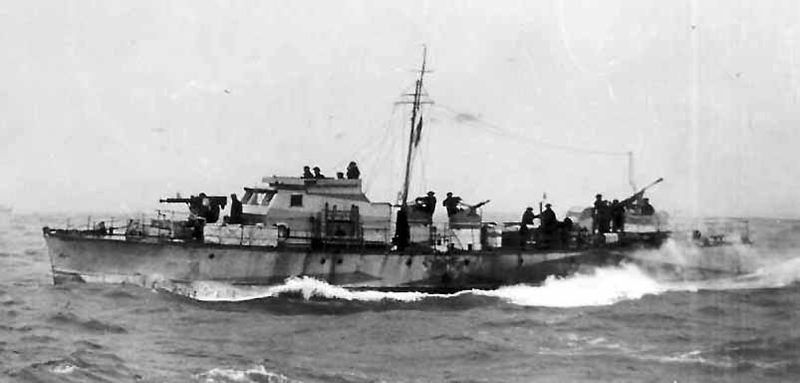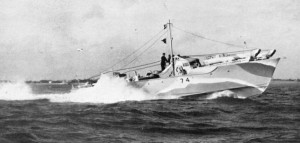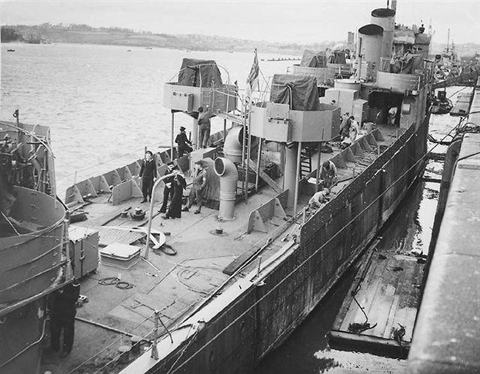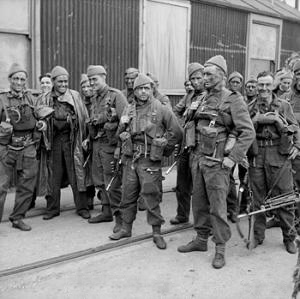 A group of British Commandos – 1942
A group of British Commandos – 1942
During World War II there were many commando raids undertaken by the countries involved. Some are well known, while others remain hidden in history. This story is about the raid that has since become known as The Greatest Raid of All.
The St. Nazaire Raid was a successful British raid on the heavily-defended dry dock and ship repair facilities at St. Nazaire (Saint-Nazaire) in German-occupied France during World War II. (A dry dock is a narrow basin that can be flooded then drained to allow a ship to come to rest on a dry platform. Dry docks are used for the construction, maintenance, and repair of ships).
St. Nazaire was targeted because the loss of its dry dock would force any large German warship in need of repairs to return to German waters rather than the safe haven the St. Nazaire facilities provided on the Atlantic coast. The Germans had around 5,000 troops with numerous artillery and anti-aircraft guns in the immediate area of St. Nazaire. The German Navy had three warships in the area: the destroyer Jaguar, an armed trawler and a minesweeper. Also in the port were some smaller gunboats and two tankers which were in the dry dock at the time of the raid. St. Nazaire was also home to a German U-Boat (submarine) Base which featured 14 bombproof “pens”. The submarine base also had workshops, ammunition magazines, offices, dormitories for the submarine crews, kitchens, and a hospital.
The raid had three objectives: the destruction of the main dry dock gates, the destruction of a second set of smaller dry dock gates along with the water pumping machinery, and the destruction of any U-Boats or other ships in the area. The plan called for a Royal Navy Destroyer loaded with explosives to ram into the main dry dock gates, then detonated after the raiders and crew escaped on smaller boats. The ship selected to ram into the dock gates was the HMS Campbeltown, which had previously been in the U.S. Navy. Campbeltown had been one of 50 destroyers transferred to the Royal Navy in 1940 as part of the Lend-Lease Program where ships and other equipment were given to Britain in exchange for bases in the Atlantic Ocean. HMS Campbeltown had 4.5 tons of explosives packed in its bow encased in concrete and was converted to look like a German destroyer. Assigned to accompany and escort the Campbeltown were two other Royal Navy destroyers, HMS Tynedale and HMS Atherstone. Motor Gun Boat (MGB) 314 would lead the raid and Motor Torpedo Boat (MTB) 74 would torpedo the smaller dry dock gates. Sixteen Motor Launches (ML) would also accompany the force. The man selected to lead the Commando force was Lieutenant Colonel Charles Newman leading around 265 commandos not counting the Royal Navy crewman on the ships and boats.
The three destroyers and boats left England at 2 P.M. on March 26, 1942 arriving off St. Nazaire around 20 hours later. HMS Campbeltown left the HMS Tynedale and HMS Atherstone at sea as a precaution and proceeded to St. Nazaire with the smaller boats. Campbeltown raised a German Naval Flag in an attempt to deceive any German lookouts into thinking she was a German destroyer.
Around the same time as the raid, five Royal Air Force Bomber squadrons made an attack on St. Nazaire as a diversion; however, one of the German Naval Officers, Kapitän zur See Mecke, thought the air raid was unusual and issued a warning for the base. The harbor defense units were ordered on high alert. During the air raid a lookout reported seeing some unusual activity out at sea, so Mecke began suspecting some type of landing and ordered extra attention to be paid to the harbor.
Around 1 A.M. on March 28, the HMS Campbeltown and the small boats entered the channel to the St. Nazaire Harbor. German searchlights illuminated the ships and a request was made by signal lamp for identification. A signalman on Campbeltown replied in German that the ship was a German ship badly damaged and needing repairs. This deception lasted only a few minutes before the German guns opened fire on the raiding group. Being only a mile from the target, the German flag was lowered and the Royal Navy Flag raised, speed was increased to maximum, and the Campbeltown and the small boats proceeded to open fire on the German shore installations. Under heavy fire, HMS Campbeltown crashed through an anti-torpedo net strung across the dry dock entrance; and at 1:34 A.M. rammed the dry dock gates, the impact forcing the ship 33 feet onto the dry dock gates.
The commandos on the Campbeltown got off the ship and split into two assault teams and five demolition teams which were tasked with destroying the dock pumping machinery and other equipment associated with the dry dock. Lieutenant Colonel Newman aboard MGB 314 was one of the first ashore. One of his first actions was to direct mortar fire onto gun positions on top of the submarine pens that was causing heavy casualties among the Commandos. Newman organized a defense that succeeded in keeping the increasing numbers of German reinforcements at bay until the demolition teams had completed their tasks. The crew of the Campbeltown had set the timers on the charges and gathered at the rear of the ship to be taken off. Almost half of the 16 Motor Launches (MLs) had been lost or knocked out of action by German fire. The remaining MLs proceeded to pick up Campbeltown crewmen and commandos from shore the best they could under covering fire from MGB 314. MTB 74 fired two delayed-action torpedoes at the second set of smaller dry dock gates and proceeded to escape with MGB 314 and the surviving MLs.
Many Commandos were still ashore when Newman realized that complete evacuation by sea was no longer possible. He gathered the surviving Commandos and issued three orders: “do our best to get back to England”, “not to surrender until all our ammunition is exhausted”, and “not to surrender at all if we can help it”. Newman led the charge across a bridge raked by machine gun fire and advanced into St. Nazaire. The Commandos attempted to get through the narrow streets of the town and into the surrounding countryside, but were eventually surrounded. When their ammunition was expended they were forced to surrender. Not all the Commandos were captured; five men reached neutral Spain, from where they eventually returned to England.
The remaining boats were attacked on the way out to sea including a vicious attack from the German destroyer Jaguar. MTB 74 and MGB 314 were sunk while some of the surviving MLs reached the HMS Tynedale and HMS Atherstone. Three of the MLs missed the rendezvous with the destroyers and proceeded on their own to England.
The explosive charges in HMS Campbeltown detonated around noon on March 28, and the main dry dock gates were destroyed. Both tankers that were in the dry dock were swept away by the wall of water and sunk. A group of German officers and soldiers who were on a tour of the ship were killed as the Germans were completely unaware of the explosives. Two days later on March 30 the torpedoes from the MTB 74, which were on a delayed fuse setting, exploded at the other dry dock gates. This raised alarms among the already weary Germans. Civilian workers cleaning up after the raid panicked and ran away from the dock area. German guards, mistaking the workers’ uniforms for British uniforms, opened fire, killing some of them.
The raid put the dry dock out of commission until the end of the war. The operation had been a success, but at a cost. Of the 622 men of the Royal Navy and Commandos who took part in the raid, only 228 returned to England, and five escaped via Spain. 169 men were killed with another 215 becoming prisoners. To recognize their bravery, 89 medals were awarded to members of the raiding party including five crewman of MGB 314 who were awarded posthumous medals for their actions in providing covering fire for the raiding group. Thomas Frank Durrant, a soldier serving as a gunner on one of the MLs, was killed in the action and was posthumously awarded the Victoria Cross, the highest and most prestigious award for gallantry in the face of the enemy that can be awarded to a British soldier. His award of the Victoria Cross was unique in that it is the only award given to a soldier in a naval action and it was on the recommendation of a German officer. Sometime after the raid, the captain of the German destroyer Jaguar visited the German prison camp where Lieutenant Colonel Newman was being held and told him of Durrants’ courage.
German casualties included over 360 dead, most of them killed after the raid when Campbeltown exploded. Adolf Hitler was furious that the British had been able to sail a group of ships up to the St Nazaire harbor unhindered. His immediate reaction was to refocus German attention on the Atlantic coast, and special attention was given to other ports to prevent any repeat of the raid.
The ship’s bell of HMS Campbeltown was given to the town of Campbeltown, Pennsylvania, as a gesture of appreciation for the Lend-Lease Program. This ship’s bell was later loaned by the town to the “new” HMS Campbeltown, which was commissioned in 1989, and the bell will remain on the ship as long as she is in service with the Royal Navy.
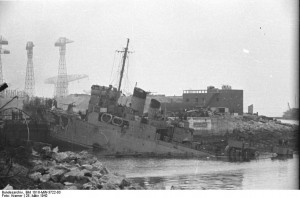 German photograph of HMS Campbeltown wedged on the main dry dock gates before the demolition charges exploded. Note German personnel on the bow of the ship.
German photograph of HMS Campbeltown wedged on the main dry dock gates before the demolition charges exploded. Note German personnel on the bow of the ship.
